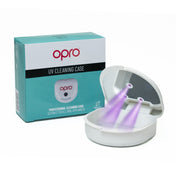Mouthguards aren’t a new invention. They’ve been around protecting sportspeople since the turn of the 20th century. But like most protective sports equipment - helmets, shin pads, shoulder pads, body protectors - they’ve evolved.
Today we have brilliant inventions like the Instant Custom-Fit, which moulds to the shape of your teeth at home in minutes, and even more recently, Prevent Instrumented Mouthguard (iMG), made by OPRO, containing cutting-edge technology. But where did it all begin?
The turn of the 20th century - London
The mouthguard began its path to becoming a sports staple at the turn of the 20th century in London. Woolf Krause, a London dentist, came up with the first mouthguard in 1890. He called it a gum shield, and many people in the UK still use this term interchangeably with the term mouthguard. Krause created the first mouthguard using gutta-percha, the latex rubber produced from the sap of the gutta-percha trees.
The 1920s
The new creation was made for boxers. In the late 1800s, boxers were accustomed to clenching a piece of wood, wool, tape, or sponge between their teeth for protection, but it was hard to concentrate. Krause wanted to find a better way to protect boxers from lip lacerations, so with the help of his son who was also a dentist as well as an amateur boxer, he worked on his design over the years.
His son went on to invent the first reusable mouthguard which debuted in a championship fight between Jack Britton and Ted “Kid” Lewis, wearing the new mouthguard in 1921. This sparked controversy, with some saying Lewis had an unfair advantage, and mouthguards experienced a small decline. But, by the late ‘20s, mouthguards were very popular among boxers in the UK and America after chipped teeth plagued the boxing community.
The 1940s
In 1947, a Los Angeles dentist named Rodney O. Lilyquist began designing mouthguards to fit individual users. He used an acrylic resin to form the first splint. Mouthguards could be moulded over upper and lower teeth, making them more comfortable, easier to wear, and less noticeable. This helped the mouthguard grow in popularity among basketball and American football players.
As these were huge sports in the USA, the mouthguard got a huge amount of exposure across the nation. Mouthguards were becoming so popular the Journal of Americal Dental Association picked up Lilyquist’s method.
The 1950s
In the ‘50s, mouthguards had gathered so much popularity the American Dental Association started researching them and publishing about their benefits to the public and sportspeople. By the ‘60s, they recommended the use of mouthguards in all contact sports, even helping to introduce new regulations.
The 1960s, 1970s, and 1980s
In 1962, all American high school football players had to wear mouthguards. In 1973, American college basketball enforced the same rule. In adult sports across the UK and in the USA, mouthguards were (and continue to be) highly recommended but not compulsory. However, with the contact experienced in sports like rugby and MMA, it seems strange not to.
The 1990s
The ‘90s gave rise to a new form of mouthguard technology creating high-heat and pressure-laminated mouthguards made from ethyl vinyl acetate dental plastic. Many companies began experimenting with thermo-plastics which eventually led to the boil-and-bite method you see in our self-fit range of mouthguards.
The 21st century
Technological advancement is affecting every aspect of our lives, and our mouthguards are no exception. The Prevent Instrumented Mouthguard (iMG), made by OPRO, is a groundbreaking innovation that monitors head impacts, identifying players who need to be assessed. In case of a diagnosed concussion, immediate intervention can help prevent further harm. Each iMG is crafted by OPRO, setting the gold standard for protection, fit, and comfort.
This data is sent to a computer monitored by medical staff during play so they can make informed decisions surrounding medical care for players. This mouthguard goes further than protecting the mouth as Krause originally designed, it will protect athletes from the harmful effects of undiagnosed concussion.
Our gum shields protect athletes during their professional careers and those new to the world of sport. Our work in this field earned us the Queen's Award for Enterprise: Innovation in 2019. We’re happy to be a part of mouthguard history. To find out more about Prevent Biometrics & OPRO and see the rest of our range, visit our website today.


